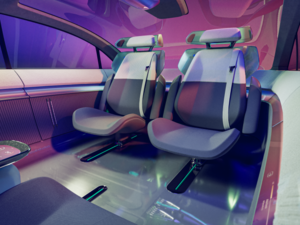Cars as a comfort zone: the evolution of the interior
Watching movies, playing games, working, or snoozing: the people who will be using automated vehicles in the future have clear ideas about how they want to pass the time it takes to reach their destination.
Their wishes call for a complete redesign of the vehicle interior, with comfortable driving characteristics to match, and this presents manufacturers and suppliers with new challenges. These are the findings of a research project led by Bosch. Called RUMBA, it looked into what people expect from automated vehicles – in terms of both interiors and driving behavior. The work of RUMBA’s business and science experts was funded with a grant of some 11 million euros from the German Federal Ministry for Economic Affairs and Climate Action. “This newly acquired basic knowledge will shape the planning of new generations of vehicles. In the future, this could lead to the creation of a completely new living and working space for users,” says Michael Schulz, who managed the project at Bosch. For example, automated cars and commercial vehicles could be converted into offices, cinemas, or even bedrooms. Many service providers see vehicles as an as-yet untapped and therefore significant market segment.
Over a period of three and a half years, a team of experts drawn from automakers, automotive suppliers, and scientific institutions investigated what users expect from future vehicles that will be able to cover longer distances automatically. Through interviews, observations, and studies, the researchers found out how professional and private drivers of cars and commercial vehicles would use their time if they didn’t have to actively sit behind the wheel and could instead take on the role of a passenger. “It became clear to us that the automation of driving creates new possibilities for using the interior,” Schulz says. For example, rather than having a conventional steering wheel, vehicles might offer users alternative control elements that are tailored to user requirements during manual and automated driving. “Steer-by-wire technology would open up unprecedented new possibilities for interior design, with scope for many innovative functions and features,” he adds. Driverless automated commercial vehicles are also expected to bring about major changes in the logistics sector. “The design of the future driver’s cab is heavily dependent on the usage scenario: it can be optimized both for short manual journeys within logistics centers and for transporting people between logistics centers,” Schulz says, summarizing another research result.
Relaxing and sleeping during the journey
The experts involved in RUMBA – a German acronym for “Realization of a positive user experience by means of user-friendly interior design for automated driving functions” – faced a number of challenging requests from users. For example, they spent a lot of time investigating how quickly a person can take back control of a vehicle after sleeping, and what factors have an impact on this. They also learned that if drivers have previously adopted a more relaxed sitting position, then another decisive factor for how long it takes to return the vehicle to manual control is the driver’s distance from the display and control elements. Studies conducted as part of RUMBA showed that for a large number of participants, a period of 60 seconds following a sleep phase was long enough. But the studies also identified deficits in driving performance and a deterioration in subjective well-being after taking back control. The researchers came to the conclusion that the vehicle must rouse the user well in advance to ensure they have sufficient time to wake up, find their bearings, and react. This also requires the technology to be able to recognize the occupants’ condition and assess whether they are sleeping or awake and ready to take the wheel.
As gentle as a chauffeur
Furthermore, the project investigated the handling characteristics that automated vehicles will have to deliver. “This is an important part of ensuring that drivers and passengers can feel comfortable and safe in future vehicle interiors,” Schulz says. A vehicle that moves off abruptly or brakes hurriedly could make occupants feel nauseous and reduce acceptance of automated driving functions. With this in mind, the experts closely observed how gently and carefully professional drivers drive their vehicles, and then transferred their findings to the automated vehicles. They also examined which additional measures are effective in preventing travel sickness.
Space to try something new
Over the course of the project, the researchers also analyzed which color schemes, which materials and designs, which lighting schemes, and which control elements would be suitable for use in future interior designs, taking into account the situation during a given journey. One thing the researchers clearly recognized, however, was that users’ wishes will continue to be bounded by security and technical requirements in the future. For accident safety reasons and due to the limited space available, features such as seats that can be turned while driving will continue to pose a challenge, even in large vehicles. Overall, though, the experts concluded that the vehicles of the future will open up unprecedented opportunities – not only for automakers and automotive suppliers, but also for service providers, who have had little involvement in vehicles to date. Schulz summarizes the result of RUMBA as follows: “Our project has opened the door to the development of a wide range of innovations. We’re convinced that the insights we’ve gained will help shape the way people experience individual mobility in the future.”
You can find more information about RUMBA here: https://projekt-rumba.de/en/
Pictures: Bosch





